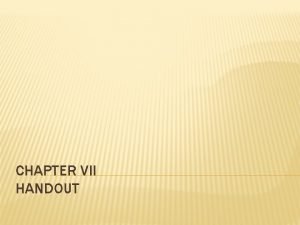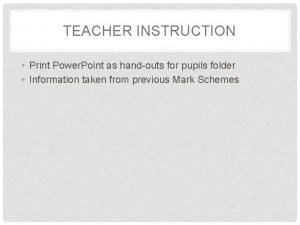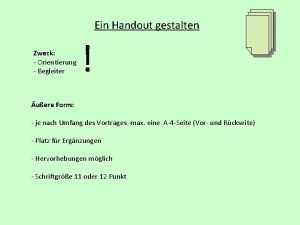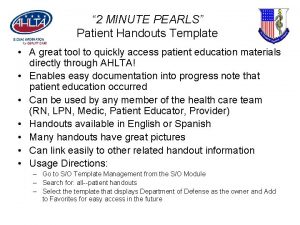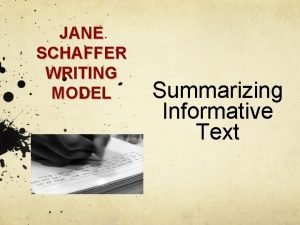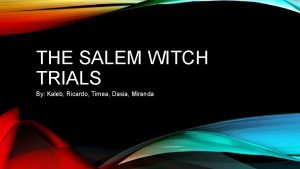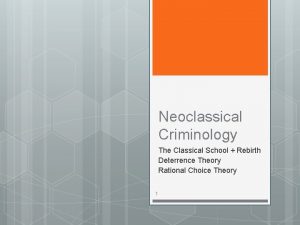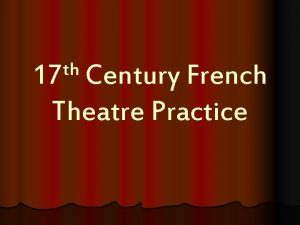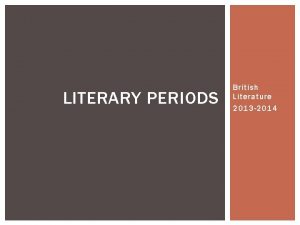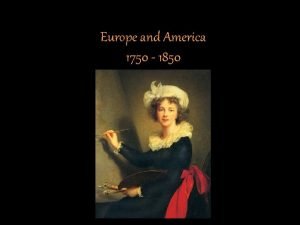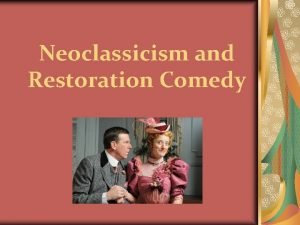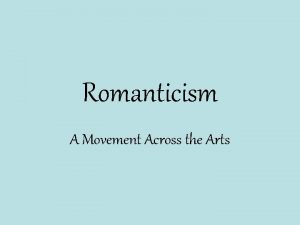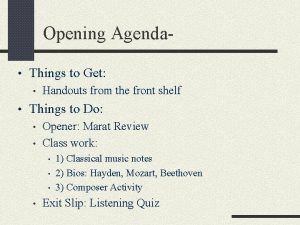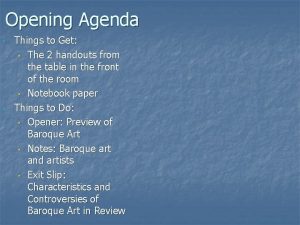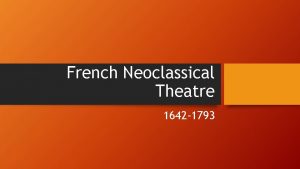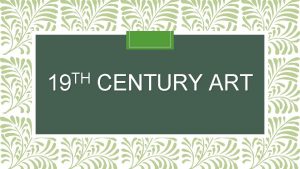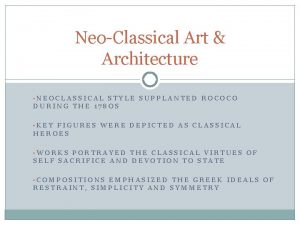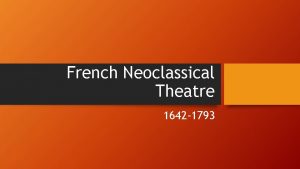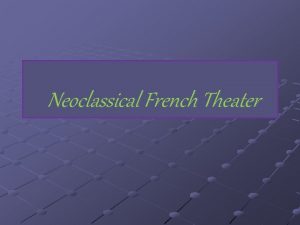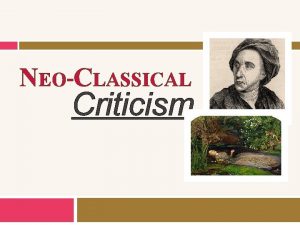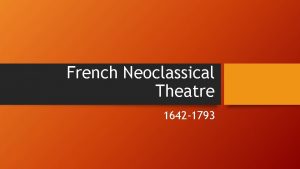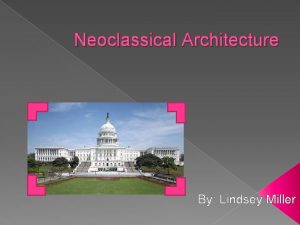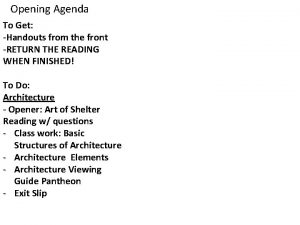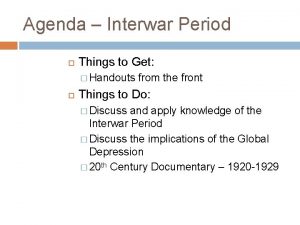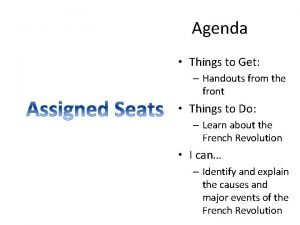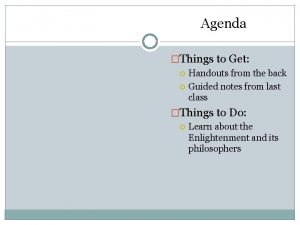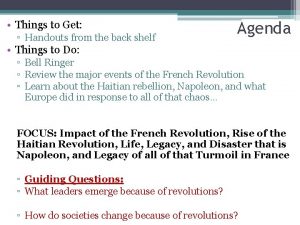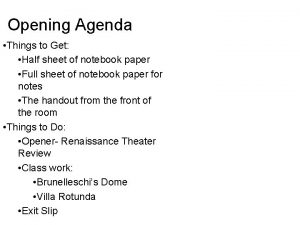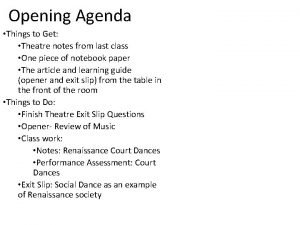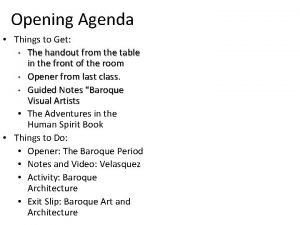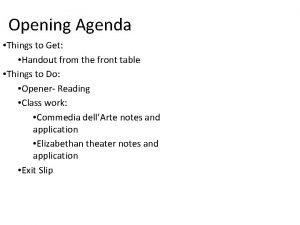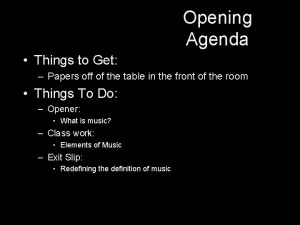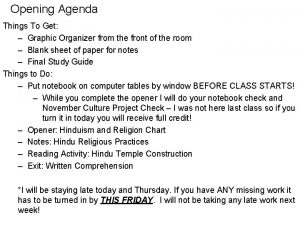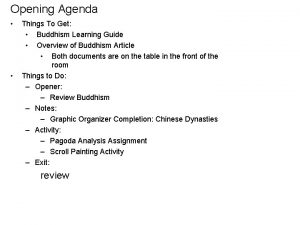Opening Agenda Things to Get Neoclassical Handouts from
































- Slides: 32

Opening Agenda • Things to Get: – Neoclassical Handouts from the front shelf • Things to Do: – Opener: Intro to the Enlightenment – Class work: Influence on the Revolutions – Exit Slip: Application of knowledge – Review Exam Scores

Baroque Review – Page 108 Match the following names with the correct term Velazquez Bernini Bach Caravaggio Jean Baptiste Lully Handel Palace of Versailles Rembrandt Christopher Wren Vivaldi Violin Virtuoso Las Meninas Oratorio Ecstasy of St. Teresa Conversion of St. Paul Hall of Mirrors St. Paul’s Cathedral Organ Ballet The Night Watch

Image from pg. 294 Description

Title: The Enlightenment Opener • • Pg. 294: Top of the page, beginning with “It is a Scene…” 1) Describe eighteenth century nobility life. 2) Define the spirit of enlightenment. 3) How did aristocratic life differ from middle-class life? Pg. 296: Key Concept 4) What was the Enlightenment’s philosophical goal? 5) What did thinkers feel an Enlightenment education would lead to? 6) What type of world government could Enlightenment ideals lead to? • 7) Complete the following sentence: “Kant believed that world peace required only the application of sufficient _________. ” (296) • • Answer these questions on pg. 108 of your VPA notebook.

Check your answers! 1) Leisured decadence who threw parties in elegant gardens, town houses, and country manors 2) The belief in the supremacy of reason over pleasure, and a conviction that humans could perfect society through the application of the intellect to human affairs. 3) Middle class: sober advocates of reason and enlightenment endured an uneasy coexistence with an aristocratic society devoted to artful pleasure. 4) Educate citizens so that they could exercise their powers of reason unhindered by tyranny and superstition. 5) World peace and general prosperity 6) One that guaranteed equal rights and universal education 7) Human reason

http: //www. nlm. nih. gov/exhibition/smallpox/Images/Large/map. jpg The Enlightenment and Revolutions Pg. 108 (top right) • Between the 1700 and 1800, the world was drastically transformed by intellectual, mechanical, social, and political revolutions.

http: //www. nlm. nih. gov/exhibition/smallpox/Images/Large/map. jpg While watching the following video, answer the question below in your notes: • What was the Enlightenment? – How is the Enlightenment defined? – http: //www. youtube. com/watch? v=4 Vkx 7 h. NXE 3 Y Pg. 108 (top right)

Why? http: //images. easyart. com/i/prints/rw/en_easyart/lg/1/4/The--Jeu-du-Roi--gaming-table-in-the-court-of-Louis-XV-Anonymous-144260. jpg • During the 1600’s, Absolute monarchs lived in lavish courts that were decadent and self serving. • Long term effect: – France: Lavish court life was disconnected from the average individual • France’s national debt grows • New Political Thought develops

The Enlightenment • Emphasized the mind’s ability to reason http: //www-gap. dcs. stand. ac. uk/~history/Big. Pictures/Hobbes_3. jp eg http: //www. ubourgogne. fr/cimeos/CRCM/images/stories/ dossier. Serge/diderot. jpg • Secular concerns http: //www. diplomatie. gouv. fr/en/IMG/jpg/ 58 l 1. jpg • Main ideas: – Freedom from tyranny and superstition – Belief in goodness of human nature – Equality of men http: //www. harpers. org/media/image/bl ogs/misc/edmund-burke. jpg

Society went Baroque… so society became Classical!

Characteristics of the Neoclassic Period • Reaction to the Baroque Period caused… – Political thinkers to ponder Revolutions to create democracies and republics (a la Greece and Rome) so that people would have a voice in government – artists, musicians, and architects wanted to emulate the clean, uncluttered style of Classical Greece and Rome in their works • If countries are baroque from the Baroque movement, who is paying for art? – The aristocracy were the main patrons of the arts. • Aristocracy: non-royals who have lots of money – The Church and Monarchs were no longer the principle benefactors of the arts due to the political upheaval in Europe at the time.

Baroque or Not? • Picture matching activity – Review what’s Baroque and identify what’s Classical • What about Baroque Art influenced people to prefer the cleaner and more simplistic style of the Neoclassic Period?







Origins of Neoclassic Art • Discoveries and publications of and about antiquity also allowed for Classicism to become the new, favored, style. 1. Excavations of Pompeii and Herculaneum 2. Elgin Marbles 3. Johann Winckelmann’s Artists Circle Pg. 109

1. Excavations of the Ruins of Italian Cities Pompeii in 1748. Herculaneum in 1738. http: //www. youtube. com/watch? v=F 4 Hguzr. Uu. CY Pg. 109 http: //www. youtube. com/watch? v=4 mg 0 j 7 Uzsg 0&feature= related

Pompeii in Cincinnati How did the shapes of bodies get preserved? • ADD IMAGES!

Pg. 109 2. Elgin Marbles Thomas Bruce, 7 th Lord of Elgin British Museum, 1806 http: //www. youtube. com/watch? v=g. Fl. W 9 gd 9 REI From the top façade of the Parthenon in Athens.

3. Johann Winckelmann’s Artists Circle German art historian. Pg. 109 $ Artists should “imitate” the timeless, ideal forms of the classical world. $ international artists gathered about him in the 1760 s in Rome. $ Ideas discussed/shared in coffee houses (poor man’s universities) http: //www. youtube. com/watch? v=Sb. RGIFI Bc. Qk

Neo-Classical Sculpture Characteristics $ Profoundly influenced by ancient art since the Renaissance. $ Neo-Classical sculptors avoided the dramatic twisting poses and colored marble surfaces characteristic of late Baroque and Rococo sculpture. $ They preferred: S Crisp contours. S A noble stillness. S Idealized white marble forms.

Antonio Canova “Apollo Crowning Himself, ” 1781 “Perseus with the Head of Medusa, ” 1804 -1806 Write down the information about Canova on the bottom of page 109. Sketch the Perseus sculpture.

Sculpture Donatello Michelangelo Canova • How are they different? Bernini

How is this statue of George Washington sculptured in the style of Neoclassicism?

Can you demonstrate a noble stillness? • Objective: – To demonstrate your understanding of Neoclassic sculpture characteristics • Assignment: In groups of two, you must – create a Neoclassic sculptural pose – take a picture of it on your cellphone – Email it to (extra credit! +5 on exam) colin. broderick@fayette. kyschools. us • Pose Requirements: – You must demonstrate ALL characteristics of classic sculpture without the nudity • Reference Canova’s Perseus, Donatello’s David, and your notes on Characteristics of Neoclassic sculpture for what a Neoclassic sculpture looks like

Neo-Classical Painting Characteristics • Clean lines • Geometric arrangement • Classical themes with contemporary clothes and settings • Emotion is not the main force in the pieces. – Why? Political leaders of the Enlightenment (right to life, liberty, property) distrusted emotions as a guide to the truth; they relied on human reason. Pg. 109

• Objective: Activity – To demonstrate your knowledge of Neoclassic art subjects • Assignment: – Match the description provided with one of the images given – On your handout, sketch the image, summarize the subject, and write the title – Use the article found on pg. 110 to complete this assignment found on pg. 109 • Time allowed: – 15 minutes.


1. 2. 3. 4. Exit Slip Should the Elgin Marbles be returned to Greece? Why or why not? Explain! How did sculpture change in the Neoclassic period versus the Baroque? Explain! Why was Pompeii significant in the development of the Neoclassic Period? Explain! Name two ways in which Neoclassic Painting differed from Baroque Painting.
 Get on get off get into get out of
Get on get off get into get out of Shot me out of the sky you're my kryptonite
Shot me out of the sky you're my kryptonite Agenda sistemica y agenda institucional
Agenda sistemica y agenda institucional Gapped handouts
Gapped handouts Sample of handouts
Sample of handouts Define handouts
Define handouts Advantages and disadvantages of handouts
Advantages and disadvantages of handouts Handout gestalten schule
Handout gestalten schule Www.studenthandouts.com
Www.studenthandouts.com Zoo103 handouts pdf
Zoo103 handouts pdf Advantages and disadvantages of handouts
Advantages and disadvantages of handouts Patient handout template
Patient handout template Cs408 handouts
Cs408 handouts Student handouts.com
Student handouts.com Jane schaffer 2 chunk paragraph example
Jane schaffer 2 chunk paragraph example Student handouts inc
Student handouts inc Cs408 handouts
Cs408 handouts Get up get moving quiz
Get up get moving quiz Get focused get results
Get focused get results Get up get moving quiz
Get up get moving quiz Get up get moving quiz
Get up get moving quiz Get up get moving quiz
Get up get moving quiz Repetition in pseudocode
Repetition in pseudocode Get to know you questions for adults
Get to know you questions for adults What options did an accused witch have in salem
What options did an accused witch have in salem Venn diagram of living and nonliving things
Venn diagram of living and nonliving things Seven life processes pictures
Seven life processes pictures Neoclassical criminology
Neoclassical criminology Racinell
Racinell Timeline of literary periods in british literature
Timeline of literary periods in british literature Napoleon crossing the alps neoclassical or romantic
Napoleon crossing the alps neoclassical or romantic What is comedy of manners
What is comedy of manners Enlightenment vs romanticism
Enlightenment vs romanticism





